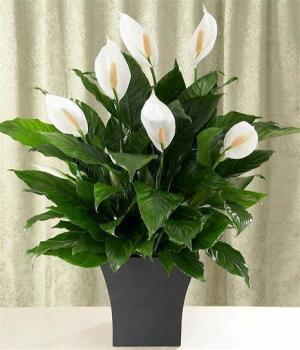Peace Lily is beautiful and filters out harmful chemicals
In NASCAR racing, a white flag tells drivers that there is one more lap to go. In battle, the white flag is the international sign of surrender or truce, and the white flag is carried by diplomats, meaning they come in peace. So, when explorers to Colombia found a plant waving a pure white flag, it quickly became known as the Peace Lily. The plant's “flag” is actually a spathe, or leaf-like bract that hides the true flower of a plant, in this case the tiny, unremarkable flowers of Spathiphyllum wallisii.
Because Peace Lilies are tropical, evergreen plants that naturally grow on the jungle floor, getting by with just dappled sunlight, they are a good plant for homes and offices where sunlight is not strong.
In spite of its name, the Peace Lily is not a true member of the lily family (Liliaceae). It is only mildly toxic, whereas true lilies are very poisonous to cats and dogs.
The Peace Lily is not only beautiful, with its dark-green leaves and bright-white flowers, it also actually filters out harmful chemicals from the indoor air. The effect is minor, but a nice bonus just the same.
At just 16 inches tall, these plants fit in almost anywhere around the house or office. You can even bring them outdoors during the warmer days of summer, but bear in mind they are tropical plants, so even a light frost will kill them.
When potting up a Peace Lily, use a potting mix that drains well. For best results, repot them once a year in the spring using fresh potting soil. Over time, your Peace Lily will need to be divided. Tap the plant out of its pot, taking care not to beak the stems or roots, and carefully divide the cluster of plants. Take care to keep several leaves in each clump. Because the Peace Lily grows from rhizomes, it can take a bit of rough handling when divided and still grow back into a healthy plant.
You can even grow Peace Lilies in water alone. When placed in clear vases, they look quite dramatic in modern settings. If growing in water, be sure that the base of the plant is suspended above the water line, with a layer of pebbles or small stones. This way the roots can reach the water, but the base of the plant is not sitting in water, which can make it rot and die.
Speaking of water, for potted Peace Lilies, keep the soil moist, but not soggy. They can go for short periods with no water, but if left dry too long, the leaves will droop and turn brown. For best results, only use filtered water; avoid tap water that may contain chemicals such as chlorine and fluoride.
Mist your Peace Lilies to increase humidity. For added humidity set the pot on a tray scattered with stones or pebbles, then filled with water. As the water in the tray evaporates, it increases the humidity around the plant.
Peace Lilies do not need much fertilizer, so only feed them when they are actively growing in the spring and summer. Fertilize every six or seven weeks or so with an organic houseplant fertilizer. If your plant is attacked by scale or mealybugs, simply wipe down the leaves with a weak solution of mild dish detergent or insecticidal soap.
Being tropical plants, Peace Lilies do best with temperatures above 60°F, so the average home or office is ideal. Keep them away from drafts or heating vents.
Place your Peace Lilies where they will get light but out of direct sunlight, which can scorch the leaves. If your Peace Lily stops blooming, it probably needs more light. Try moving it closer to a window or even under grow lights.
Put a Peace Lily in your home or office, and you can surrender to a carefree houseplant that will brighten dark spots with white flags. And that may call for a victory lap.
















































